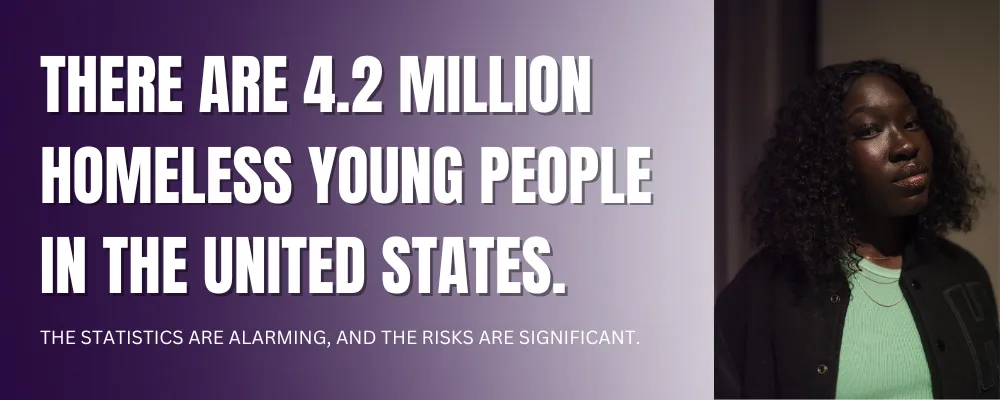THE REALITY

Homeless youth are found living on the streets in major cities, small towns, and many suburbs across the United States. Some may stay in low-cost hotels, parks, abandoned buildings, or other precarious locations for varying periods. Many of these young people face tough decisions daily just to survive.
While some cities have shelters, most do not provide sufficient beds for youth.
Sobering Statistics
• 1.7 million U.S. youth experience homelessness each year.
• 50,000 youth spend six months or more sleeping on the streets annually.
• 1 in 5 children between ages 10 and 18 will run away.
• Up to 40% of homeless youth identify as LGBTQ.
• Every day, 13 at-risk youth die due to assault, illness, or suicide while trying to survive on the streets—totaling approximately 5,000 per year.
• About 25% of youth become homeless within a year of aging out of the foster care system.
• Homeless youth are 75% more likely to self-medicate and abuse substances compared to their housed peers, as a way to cope with trauma.
You can learn more about youth homelessness through the National Network for Youth and the National Alliance to End Homelessness.
Four Common Pathways to Homelessness
The National Network for Youth, of which we are a member, has identified four primary causes of youth homelessness:
• Family Instability: This includes child abuse and neglect, domestic violence, parental substance abuse, and family conflicts, particularly those related to sexual orientation or gender identity.
• System Involvement: Youth who age out of the foster care system or are released from juvenile detention often face homelessness. A significant percentage of these young people struggle to find stable housing after leaving these systems.
• Residential Instability: Economic challenges often lead to residential instability, sometimes resulting in youth becoming homeless alongside their families. However, they may be separated from their families due to shelter limitations, transitional housing policies, or child welfare regulations.
• Extreme Disconnection: A lack of connection to education, employment, and support networks also contributes to homelessness.
Many youths who have experienced these situations and become homeless have endured significant trauma, which needs to be addressed as they work towards gaining independence and securing permanent housing.
Categories of Youth We Assist
• Early Runners: Youth displaced from their homes due to severe conflict, abuse, or neglect, often experiencing short-term homelessness.
• Doubled-Up: Transition-age youth who cannot return home and need housing combined with life-skills training.
• Older, Employed Homeless Youth: Highly mobile individuals who have part-time or full-time employment but lack access to affordable housing.
• Street-Dependent Youth: Youth who have been sleeping outside, in public spaces, or in abandoned buildings for six months or more, requiring services to help them reintegrate into society.
• Homeless Youth with Long-Term Disabilities: Youth experiencing cognitive or emotional challenges who will need ongoing support into adulthood.
Living on the streets puts youth at risk for:
• Being trafficked
• Contracting severe illnesses
• Experiencing sexual violence
• Suffering from physical violence
• Facing unintended pregnancies
• Misusing drugs and alcohol
• Dealing with untreated mental health issues
• Attempting or committing suicide
THE REALITY

Homeless youth are found living on the streets in major cities, small towns, and many suburbs across the United States. Some may stay in low-cost hotels, parks, abandoned buildings, or other precarious locations for varying periods. Many of these young people face tough decisions daily just to survive.
While some cities have shelters, most do not provide sufficient beds for youth.
Sobering Statistics
• 1.7 million U.S. youth experience homelessness each year.
• 50,000 youth spend six months or more sleeping on the streets annually.
• 1 in 5 children between ages 10 and 18 will run away.
• Up to 40% of homeless youth identify as LGBTQ.
• Every day, 13 at-risk youth die due to assault, illness, or suicide while trying to survive on the streets—totaling approximately 5,000 per year.
• About 25% of youth become homeless within a year of aging out of the foster care system.
• Homeless youth are 75% more likely to self-medicate and abuse substances compared to their housed peers, as a way to cope with trauma.
You can learn more about youth homelessness through the National Network for Youth and the National Alliance to End Homelessness.
Four Common Pathways to Homelessness
The National Network for Youth, of which we are a member, has identified four primary causes of youth homelessness:
• Family Instability: This includes child abuse and neglect, domestic violence, parental substance abuse, and family conflicts, particularly those related to sexual orientation or gender identity.
• System Involvement: Youth who age out of the foster care system or are released from juvenile detention often face homelessness. A significant percentage of these young people struggle to find stable housing after leaving these systems.
• Residential Instability: Economic challenges often lead to residential instability, sometimes resulting in youth becoming homeless alongside their families. However, they may be separated from their families due to shelter limitations, transitional housing policies, or child welfare regulations.
• Extreme Disconnection: A lack of connection to education, employment, and support networks also contributes to homelessness.
Many youths who have experienced these situations and become homeless have endured significant trauma, which needs to be addressed as they work towards gaining independence and securing permanent housing.
Categories of Youth We Assist
• Early Runners: Youth displaced from their homes due to severe conflict, abuse, or neglect, often experiencing short-term homelessness.
• Doubled-Up: Transition-age youth who cannot return home and need housing combined with life-skills training.
• Older, Employed Homeless Youth: Highly mobile individuals who have part-time or full-time employment but lack access to affordable housing.
• Street-Dependent Youth: Youth who have been sleeping outside, in public spaces, or in abandoned buildings for six months or more, requiring services to help them reintegrate into society.
• Homeless Youth with Long-Term Disabilities: Youth experiencing cognitive or emotional challenges who will need ongoing support into adulthood.
Living on the streets puts youth at risk for:
• Being trafficked
• Contracting severe illnesses
• Experiencing sexual violence
• Suffering from physical violence
• Facing unintended pregnancies
• Misusing drugs and alcohol
• Dealing with untreated mental health issues
• Attempting or committing suicide

